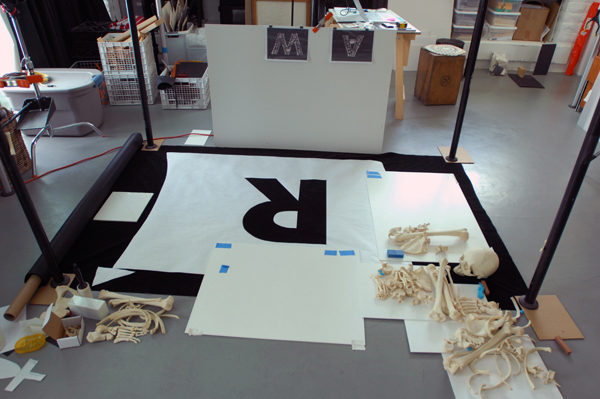“So, what’s the motto today?”
Rick Valicenti opens with this line at the offices of Thirst, a Chicago-based graphic design firm run by himself and partners John Pobojewski and Bud Rodecker. It’s a confusing question, because, for nearly 30 years, Thirst has been run, without falter, on the principle “Art with Function.” It’s an appropriate ethos, considering that its roster of clients includes architect Jeanne Gang, designerRon Arad, Herman Miller, the Harvard Graduate School of Design, and Wright auctions. Despite what it suggests, however, something much more subtle is at play: fluidity between creative experiments and client work, publisher and printer, books and video. Valicenti’s question hints at this, revealing a dedication to vision, but also an attention to the particularities of the current moment.
In 1965, Fluxus artist Dick Higgins coined “intermedia” to describe the medium-defying work that he and many other visual artists were undertaking at the time. Pobojewski mentions that this idea is integral to the workings of Thirst, where each project is imagined with a conceptual and material looseness in search of a full impact. The firm does this most freely in its long series of self-published work, such as Suburban Maul, a series of images depicting an alternate reality where big-box companies own and brand mansions in the Barrington suburb of Chicago. And there’s Intelligent Design, a reprint of Genesis in binary code but with icons of Pepsi One and Coke Zero standing in for the numerals. For Valicenti, these projects are as important as commissioned work. “Thirst has always tried to be present, separate from the binds of service.” Its creative experiments, which mix current events and cultural observations, provide opportunities to flex this freedom and answer a question posed by Higgins in his 1966 essay, “Statement on Intermedia”: “Having discovered tools with an immediate impact, for what are we going to use them?”

Rick Valicenti by Jon Shaft
These self-published projects are not just demonstrations of graphic prowess or observations on the current state of affairs. As Valicenti points out, “They are as much a stunt as they are a tool. After each one, the office is more effective and better at working.” These improvements to workflow are often very direct; lessons learned in one are transferred to the other. For example, Intelligent Design, the large-format, saddle-stitched, metallic-toned Book of Genesis, was automatically generated with custom scripts written by Pobojewski and Thirst collaborator Robb Irrgang.
Later, this provided the foundation for a Wright auctions book catalog, same size and format, produced with a similar database-driven workflow.
Thirst’s fluidity is probably best exemplified in its latest self-initiated work. Stop the Violence is a collaboration between Valicenti, photographer Francois Robert, and printer-turned-publisher Classic Color. Inside, Roberts’ dramatic photos of human bones placed in typographic arrangements are accompanied by a transcript of President Obama’s Nobel Peace Prize acceptance speech, typeset in the style of a field journal. The piece was punched out, line by line, by Barb Valicenti (Rick’s sister, Thirst office manager, and former court stenographer) on Rodecker’s old typewriter.
The publication would not have been possible without Classic Color, who printed and distributed 1,300 copies of the small-run publication for free. Due in large part to the generosity of Ray Bell, owner of Classic Color and close collaborator of Valicenti, the project benefits both parties. In recent years, Valicenti and Bell have redirected Classic Color’s promotional budgets towards publishing material that ought to be printed, regardless of profitability. Instead of making thousands of mundane brochures about the capabilities of its high-tech presses, Classic Color has elected to use these presses to produce stunning books that double as thoughtful marketing materials for both businesses. The project’s real ingenuity lies here; instead of transcending media, Thirst is questioning traditional roles set up by the graphic design industry, turning printers into publishers and graphic designers into editors, publishing art while maintaining palpable function.

Rick Valicenti by Jon Shaft
by Lisa Smith
photos by Jon Shaft
(via Design Bureau, 2011)



